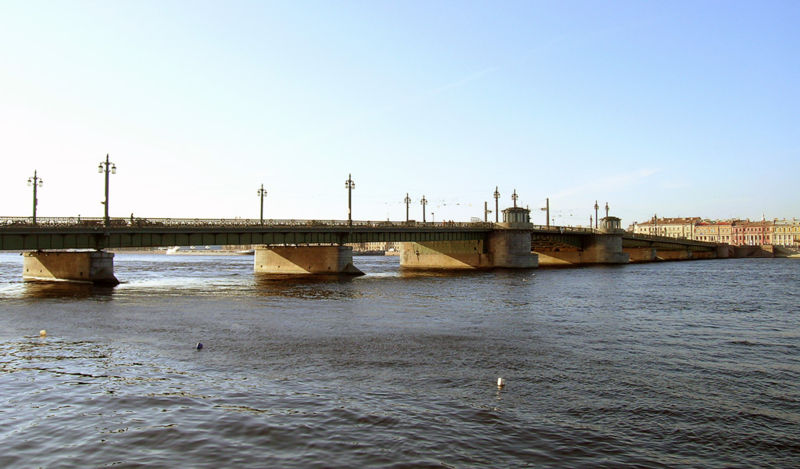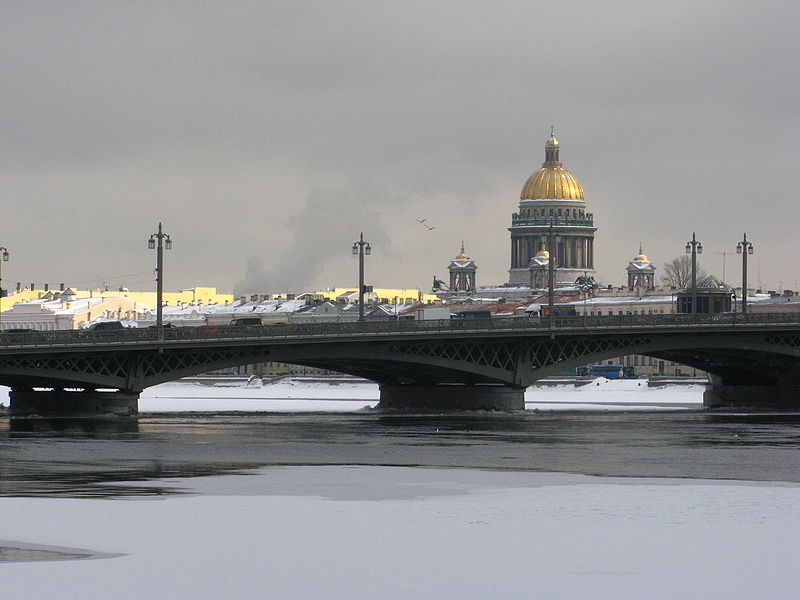Blagoveshchensky Bridge
The Blagoveshchensky Bridge (Russian: Благовещенский мост, in 1855-1918 Nikolaevsky Bridge - Russian: Николаевский мост, in 1918-2007 Lieutenant Schmidt Bridge - Russian: Мост Лейтенанта Шмидта) is the first permanent bridge across the Neva River in Saint Petersburg, Russia. It connects Vasilievsky Island and the central part of the city (Admiralteysky Island). The bridges length is 331 meters and the width is 24 meters. The bridge serves as a border between the Neva River and beginning of the Gulf of Finland.
 ( http://bestbridge.net/data/upimages/lieutenant_schmidt_bridge.jpg )
( http://bestbridge.net/data/upimages/lieutenant_schmidt_bridge.jpg )
Blagoveshchensky Bridge
Carries Pedestrian and vehicular traffic
Crosses Neva River
Locale Saint Petersburg, Russia
Design Girder bridge with a bascule section
Total length 331 m
Width 37 m
Beginning date of construction 1843, 2006
Completion date 1850 August 15, 2007
Opening date November 12, 1850

The original name of the bridge was Nevsky Bridge, later renamed to Blagoveshchensky Bridge, after the death of Tsar Nicholas I to Nikolaevsky Bridge in his honor, and in 1918 to Lieutenant Schmidt Bridge. In 1727 a temporary bridge was built at the location of the modern bridge. The place was chosen by Menshikov whose palace is located at the opposite bank. This bridge, named Issakievsky, existed until the current bridge was built, at which time it was moved to the location of where Palace Bridge is located today. The bridge was built in 1843-1850. It was designed by Stanisław Kierbedź, a Polish engineer working in Russia. The architect Alexander Brullov participated in the decoration. The construction was a cast iron bridge with a bascule section. At the time, it was the longest bridge in Europe. According to the legend, the Russian Tzar, Nicholas I promised to Kierbedź to give him a promotion for every completed flight. After the bridge was completed with eight flights total in it, Kierbedź was promoted to the rank of General, but actually when he started the construction he already had a rank of Podpolkovnik (i.e. lieutenant colonel). The bridge was formally opened on November 12, 1850. Since it was close to Blagoveshchenskaya (Annunciation) Square, it was called Blagoveshchensky Bridge. In 1855 it was renamed Nikolayevsky Bridge in memory of Emperor Nicholas I. In 1918, after the revolution, it was renamed again, this time in memory of Pyotr Schmidt, a leader of the Sevastopol Uprising during the Russian Revolution of 1905. In August 2007, after reconstruction, it was renamed back to Blagoveshchensky Bridge.